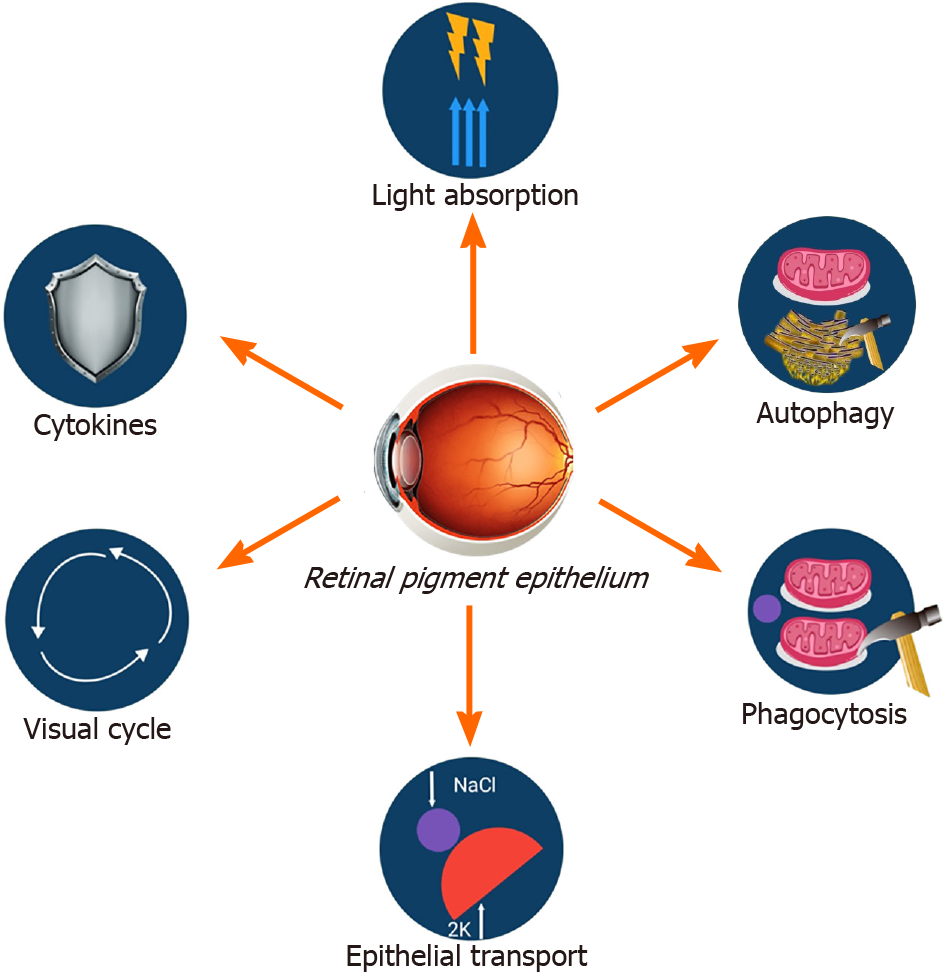Copyright
©The Author(s) 2025.
World J Stem Cells. May 26, 2025; 17(5): 103100
Published online May 26, 2025. doi: 10.4252/wjsc.v17.i5.103100
Published online May 26, 2025. doi: 10.4252/wjsc.v17.i5.103100
Figure 1 Different aspects involved in retinal pigment epithelium function.
The retinal pigment epithelium (RPE) is essential to preserve retinal health and visual function. This structure enhances light absorption via melanin granules, thereby mitigating phototoxic damage to photoreceptors. The RPE recycles visual pigments vital for phototransduction. The diagram illustrates photoreceptor outer segment phagocytosis, a process essential for retinal homeostasis and photoreceptor lifetime. Furthermore, RPE-mediated release of growth factors, including vascular endothelial growth factor and pigment epithelium-derived factor, modulates choroidal blood flow and inhibits pathological neovascularization. Specific membrane transporters allow for the movement of nutrients, ions, and waste products between the neural retina and choroid, ensuring optimal metabolic activity. The RPE preserves the outer blood-retinal barrier via tight junctions, safeguarding the retina from systemic variations and immune-mediated harm.
Figure 2 The complex network of immune responses.
A: Sources of oxidative stress to the retinal pigment epithelium (RPE). Extensive light exposure, photo-oxidative damage, phagocytosis and reactive oxygen factors can cause oxidative stress within the RPE; B: Retinal microenvironment and immune privilege. The RPE provides immunological privilege by expressing immunomodulatory molecules, including transforming growth factor-beta, Fas ligand, and complement regulatory proteins (CD46, CD55, CD59), which inhibit inflammatory responses and prevent autoimmunity. The RPE establishes a protective barrier by preserving tight junction integrity, restricting the ingress of immune cells into the subretinal area. The diagram above also depicts the function of microglia and resident immune cells within the retinal milieu, highlighting their dynamic interaction with the RPE in both normal and diseased states. Dysregulation of immune privilege may result in inflammatory retinal disorders, including age-related macular degeneration and autoimmune retinopathies, marked by complement activation and persistent inflammation. IFN: Interferon; TGF: Transforming growth factor; PEDF: Pigment epithelium-derived factor.
- Citation: Sorrentino FS, Parmeggiani F, Gardini L, Fontana L, Musa M, Gagliano C, Zeppieri M. Stem cell therapy for retinal pigment epithelium disorders. World J Stem Cells 2025; 17(5): 103100
- URL: https://www.wjgnet.com/1948-0210/full/v17/i5/103100.htm
- DOI: https://dx.doi.org/10.4252/wjsc.v17.i5.103100










